2023 TOYOTA C-HR headlights
[x] Cancel search: headlightsPage 388 of 814
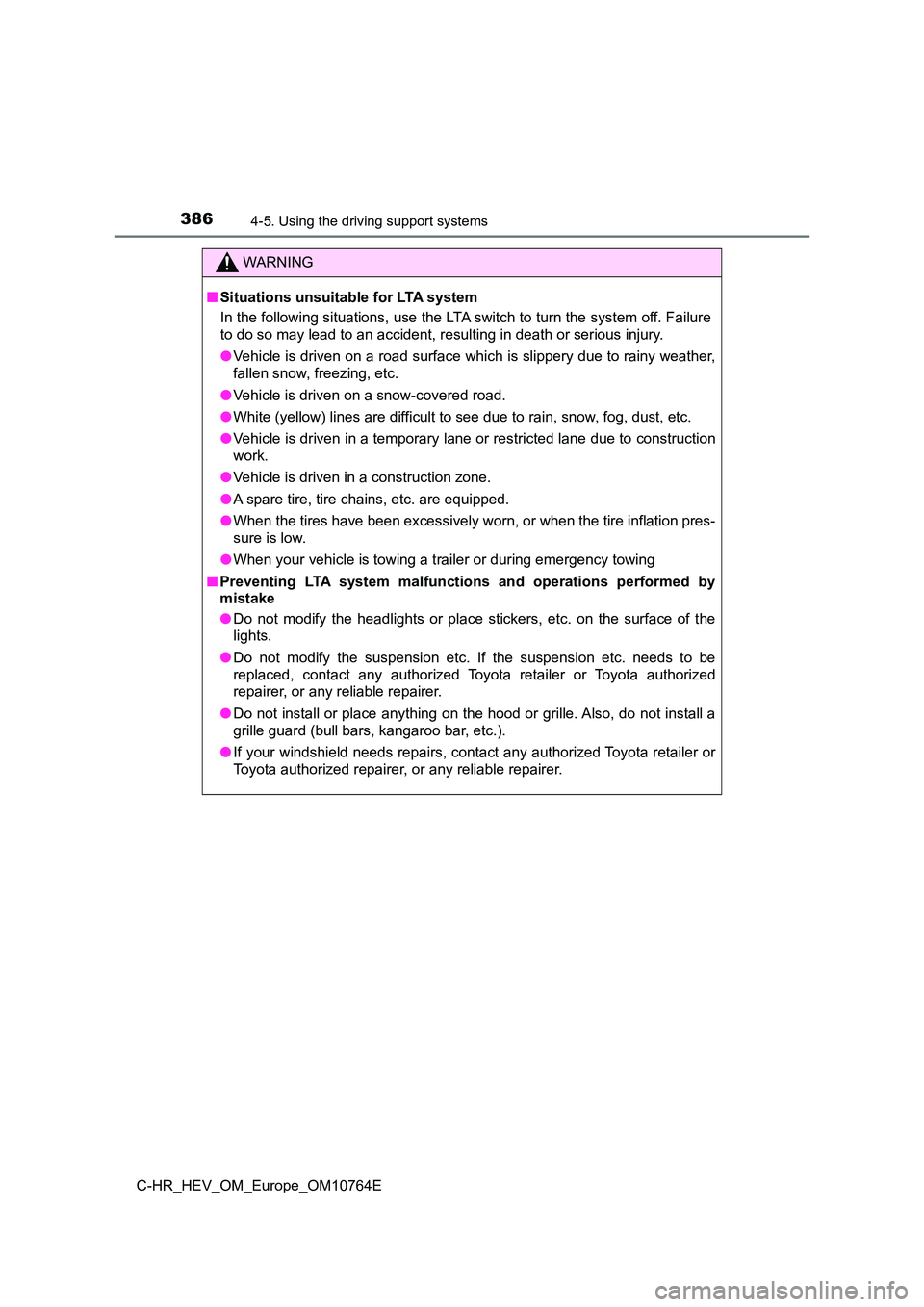
3864-5. Using the driving support systems
C-HR_HEV_OM_Europe_OM10764E
WARNING
■Situations unsuitable for LTA system
In the following situations, use the LTA switch to turn the sys tem off. Failure
to do so may lead to an accident, resulting in death or serious injury.
● Vehicle is driven on a road surface which is slippery due to rainy weather,
fallen snow, freezing, etc.
● Vehicle is driven on a snow-covered road.
● White (yellow) lines are difficult to see due to rain, snow, fog, dust, etc.
● Vehicle is driven in a temporary lane or restricted lane due to construction
work.
● Vehicle is driven in a construction zone.
● A spare tire, tire chains, etc. are equipped.
● When the tires have been excessively worn, or when the tire inflation pres-
sure is low.
● When your vehicle is towing a trailer or during emergency towing
■ Preventing LTA system malfunctions and operations performed by
mistake
● Do not modify the headlights or place stickers, etc. on the surface of the
lights.
● Do not modify the suspension etc. If the suspension etc. needs to be
replaced, contact any authorized Toyota retailer or Toyota auth orized
repairer, or any reliable repairer.
● Do not install or place anything on the hood or grille. Also, do not install a
grille guard (bull bars, kangaroo bar, etc.).
● If your windshield needs repairs, contact any authorized Toyota retailer or
Toyota authorized repairer, or any reliable repairer.
Page 391 of 814

3894-5. Using the driving support systems
4
Driving
C-HR_HEV_OM_Europe_OM10764E
WARNING
●The traffic lines are yellow (which may be more difficult to recognize than
lines that are white).
● The white (yellow) lines cross over a curb, etc.
● The vehicle is driven on a bright surface, such as concrete.
● If the edge of the road is not clear or straight.
● The vehicle is driven on a surface that is bright due to reflected light, etc.
● The vehicle is driven in an area where the brightness changes suddenly,
such as at the entrances and exits of tunnels, etc.
● Light from the headlights of an oncoming vehicle, the sun, etc. enters the
camera.
● The vehicle is driven on a slope.
● The vehicle is driven on a road which tilts left or right, or a winding road.
● The vehicle is driven on an unpaved or rough road.
● The traffic lane is excessively narrow or wide.
● The vehicle is extremely tilted due to carrying heavy luggage or having
improper tire pressure.
● The distance to the preceding vehicle is extremely short.
● The vehicle is moving up and down a large amount due to road conditions
during driving (poor roads or road seams).
● When driving in a tunnel or at night with the headlights off or when a head-
light is dim due to its lens being dirty or it being misaligned .
● The vehicle is struck by a crosswind.
● The vehicle is affected by wind from a vehicle driven in a nearby lane.
● The vehicle has just changed lanes or crossed an intersection.
● Tires which differ by structure, manufacturer, brand or tread pattern are
used.
● When tires of a size other than specified are installed.
● Snow tires, etc. are equipped.
● The vehicle is being driven at extremely high speeds.
Page 666 of 814
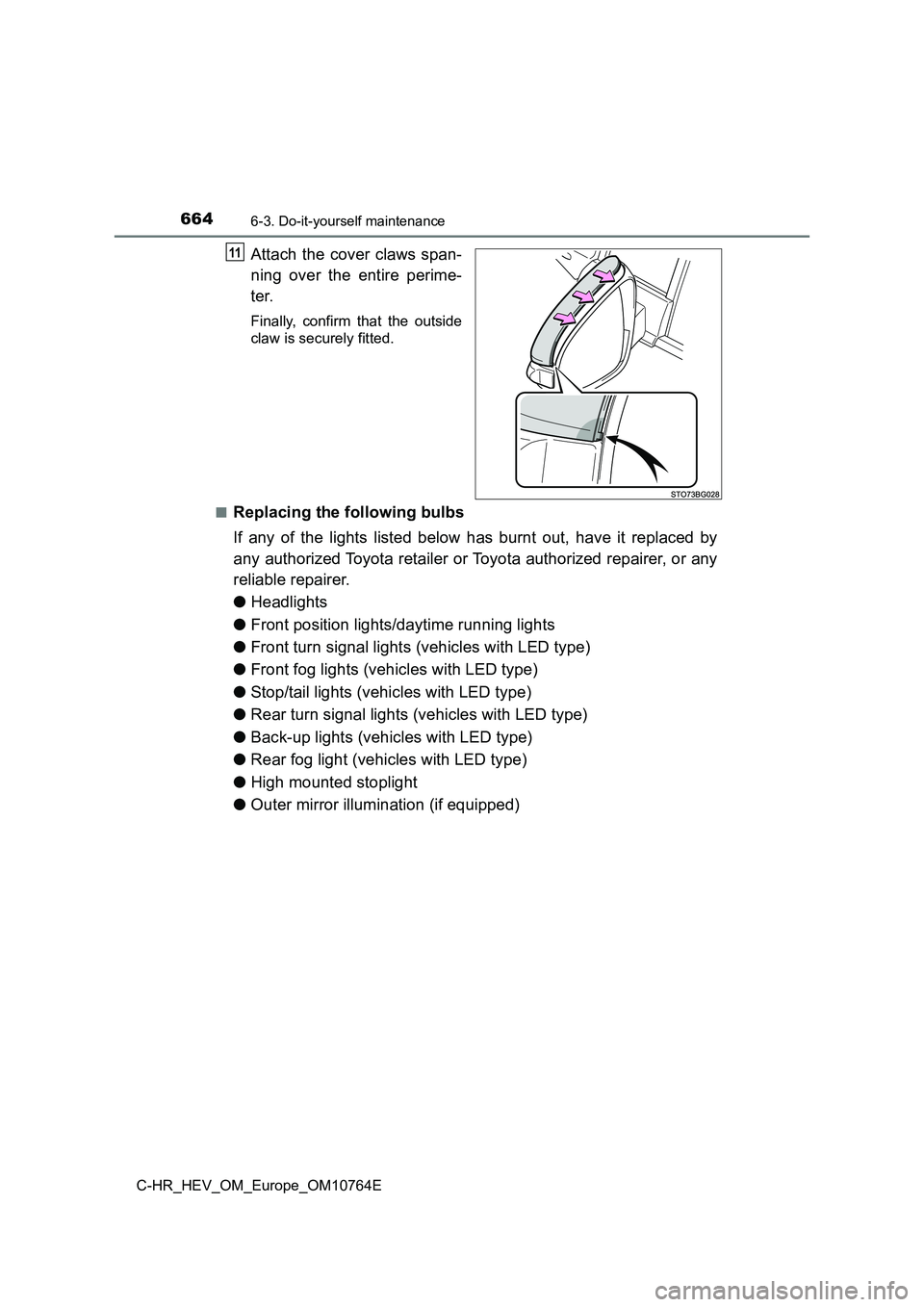
6646-3. Do-it-yourself maintenance
C-HR_HEV_OM_Europe_OM10764E
Attach the cover claws span-
ning over the entire perime-
ter.
Finally, confirm that the outside
claw is securely fitted.
■Replacing the following bulbs
If any of the lights listed below has burnt out, have it replac ed by
any authorized Toyota retailer or Toyota authorized repairer, o r any
reliable repairer.
● Headlights
● Front position lights/daytime running lights
● Front turn signal lights (vehicles with LED type)
● Front fog lights (vehicles with LED type)
● Stop/tail lights (vehicles with LED type)
● Rear turn signal lights (vehicles with LED type)
● Back-up lights (vehicles with LED type)
● Rear fog light (vehicles with LED type)
● High mounted stoplight
● Outer mirror illumination (if equipped)
11
Page 667 of 814
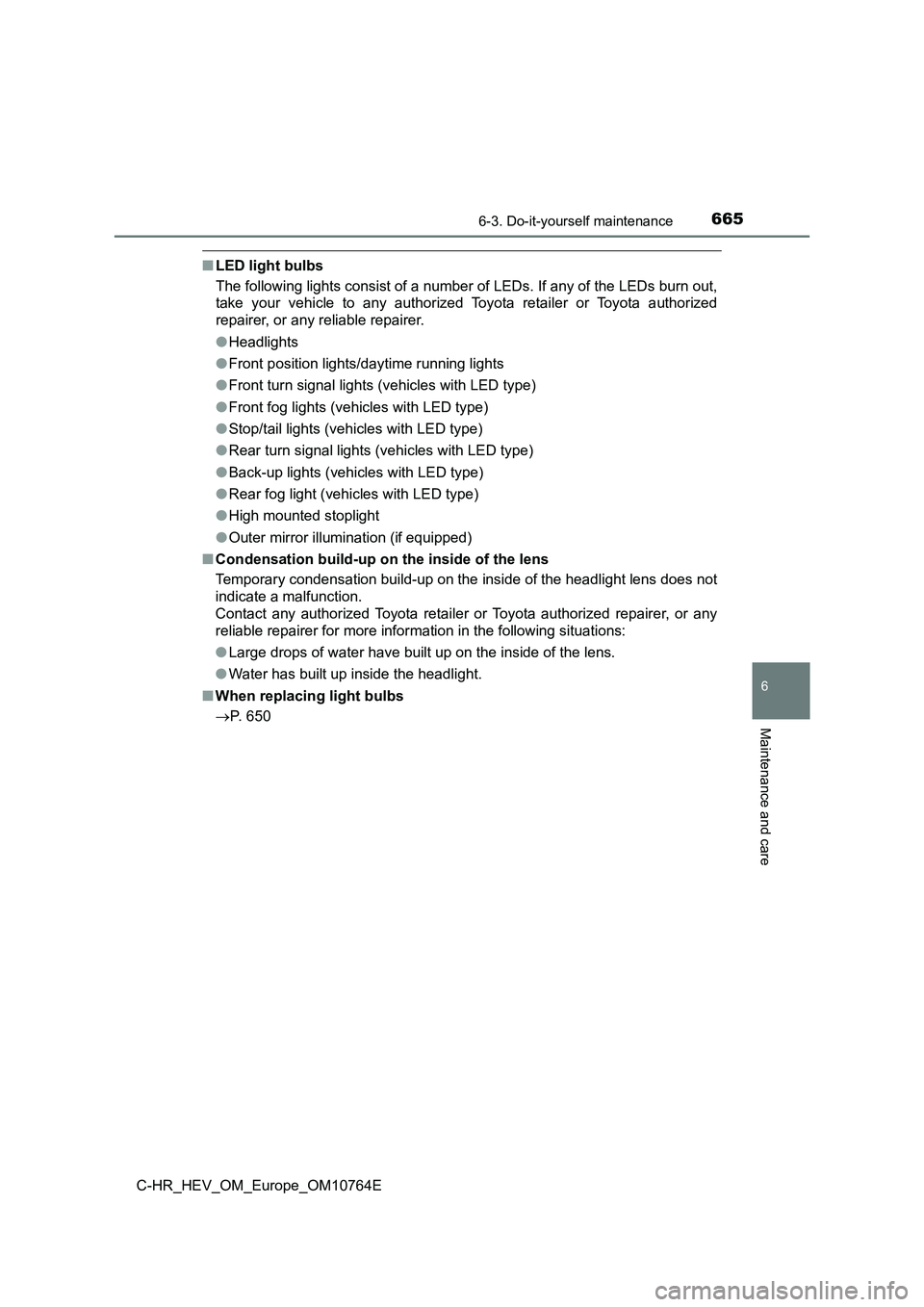
6656-3. Do-it-yourself maintenance
C-HR_HEV_OM_Europe_OM10764E
6
Maintenance and care
■LED light bulbs
The following lights consist of a number of LEDs. If any of the LEDs burn out,
take your vehicle to any authorized Toyota retailer or Toyota a uthorized
repairer, or any r eliable repairer.
● Headlights
● Front position lights/daytime running lights
● Front turn signal lights (vehicles with LED type)
● Front fog lights (vehicles with LED type)
● Stop/tail lights (vehicles with LED type)
● Rear turn signal lights (vehicles with LED type)
● Back-up lights (vehicles with LED type)
● Rear fog light (vehicles with LED type)
● High mounted stoplight
● Outer mirror illumination (if equipped)
■ Condensation build-up on the inside of the lens
Temporary condensation build-up on the inside of the headlight lens does not
indicate a malfunction.
Contact any authorized Toyota retailer or Toyota authorized rep airer, or any
reliable repairer for more information in the following situati ons:
● Large drops of water have built up on the inside of the lens.
● Water has built up inside the headlight.
■ When replacing light bulbs
P. 650
Page 668 of 814
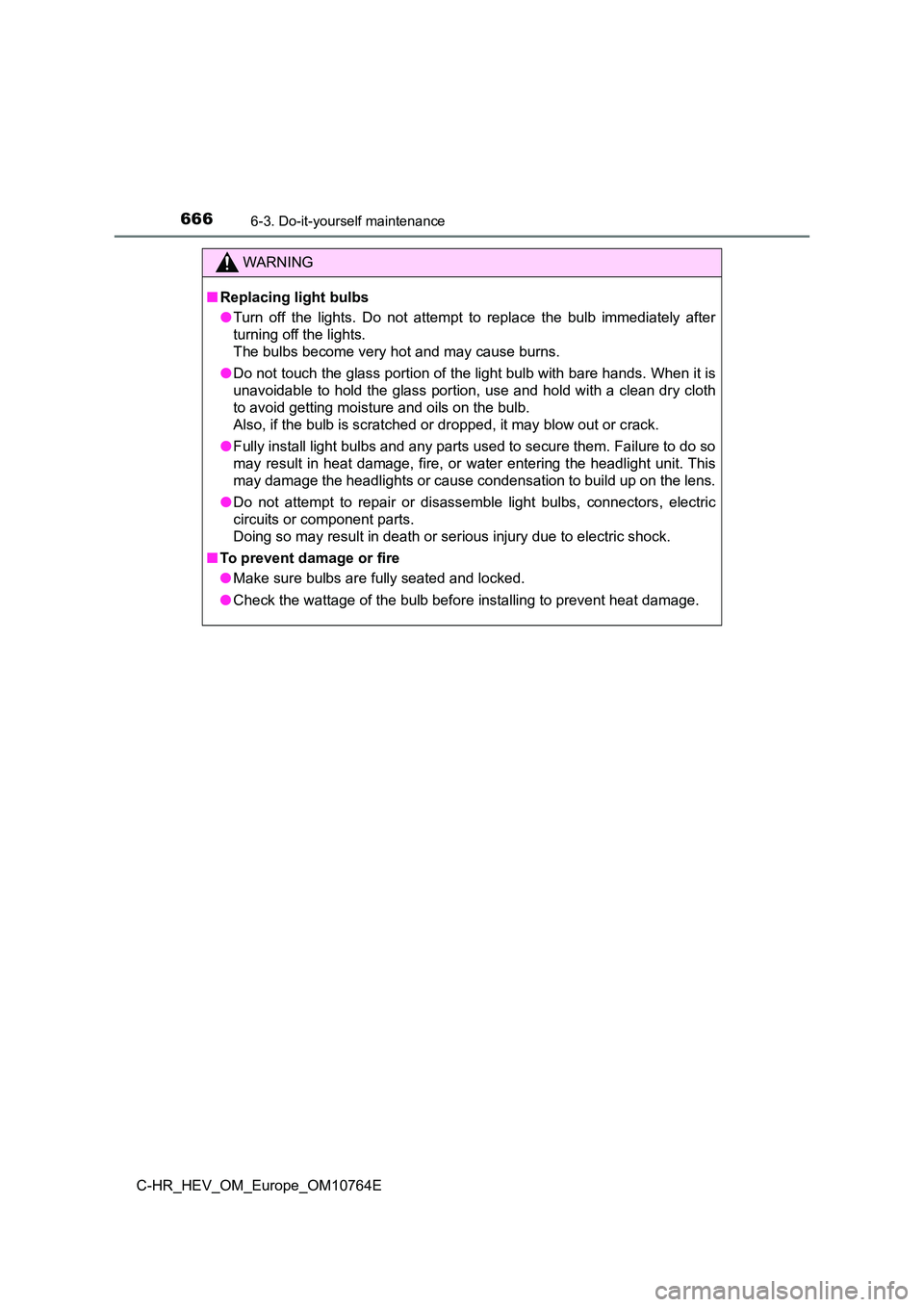
6666-3. Do-it-yourself maintenance
C-HR_HEV_OM_Europe_OM10764E
WARNING
■Replacing light bulbs
● Turn off the lights. Do not attempt to replace the bulb immediately after
turning off the lights.
The bulbs become very hot and may cause burns.
● Do not touch the glass portion of the light bulb with bare hands. When it is
unavoidable to hold the glass portion, use and hold with a clea n dry cloth
to avoid getting moisture and oils on the bulb.
Also, if the bulb is scratched or dropped, it may blow out or c rack.
● Fully install light bulbs and any parts used to secure them. Failure to do so
may result in heat damage, fire, or water entering the headligh t unit. This
may damage the headlights or cause condensation to build up on the lens.
● Do not attempt to repair or disassemble light bulbs, connectors, electric
circuits or component parts.
Doing so may result in death or serious injury due to electric shock.
■ To prevent damage or fire
● Make sure bulbs are fully seated and locked.
● Check the wattage of the bulb before installing to prevent heat damage.
Page 744 of 814
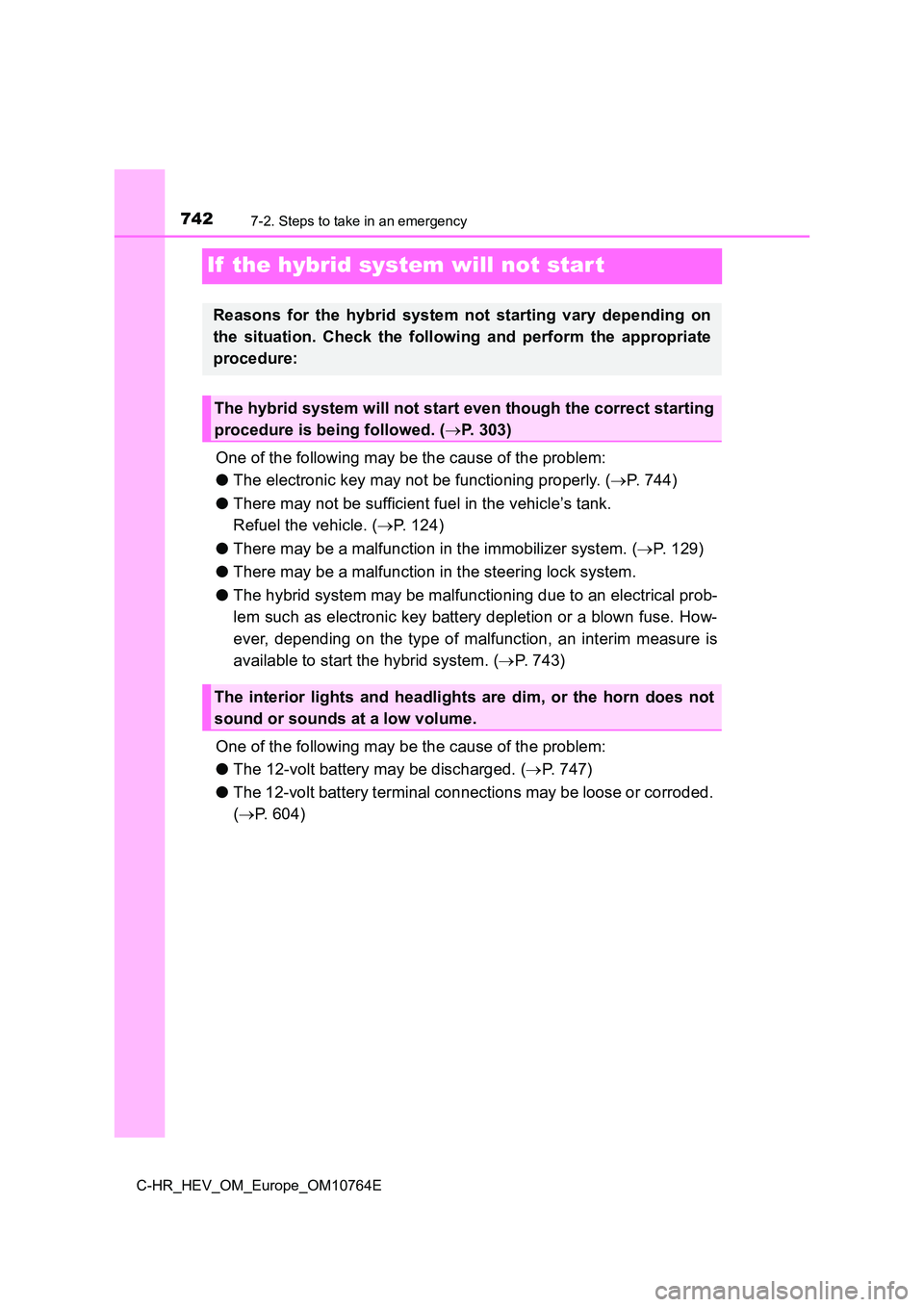
7427-2. Steps to take in an emergency
C-HR_HEV_OM_Europe_OM10764E
If the hybrid system will not star t
One of the following may be the cause of the problem:
● The electronic key may not be functioning properly. (P. 744)
● There may not be sufficient fuel in the vehicle’s tank.
Refuel the vehicle. ( P. 124)
● There may be a malfunction in the immobilizer system. (P. 1 2 9 )
● There may be a malfunction in the steering lock system.
● The hybrid system may be malfunctioning due to an electrical prob-
lem such as electronic key battery depletion or a blown fuse. H ow-
ever, depending on the type of malfunction, an interim measure is
available to start the hybrid system. ( P. 743)
One of the following may be the cause of the problem:
● The 12-volt battery may be discharged. (P. 747)
● The 12-volt battery terminal connections may be loose or corroded.
( P. 604)
Reasons for the hybrid system not starting vary depending on
the situation. Check the following and perform the appropriate
procedure:
The hybrid system will not start even though the correct starti ng
procedure is being followed. ( P. 303)
The interior lights and headlights are dim, or the horn does not
sound or sounds at a low volume.
Page 745 of 814

7437-2. Steps to take in an emergency
C-HR_HEV_OM_Europe_OM10764E
7
When trouble arises
One of the following may be the cause of the problem:
● The 12-volt battery may be discharged. (P. 747)
● One or both of the 12-volt battery terminals may be disconnected.
( P. 604)
Contact any authorized Toyota retailer or Toyota authorized repairer, or any
reliable repairer if the problem cannot be repaired, or if repa ir procedures
are unknown.
When the hybrid system does not start, the following steps can be
used as an interim measure to start the hybrid system if the po wer
switch is functioning normally.
Do not use this starting procedure except in cases of emergency .
Set the parking brake.
Shift the shift lever to P.
Turn the power switch to ACCESSORY mode.
Press and hold the power switch for about 15 seconds while
depressing the brake pedal firmly.
Even if the hybrid system can be started using the above steps, the
system may be malfunctioning. Have the vehicle inspected by any
authorized Toyota retailer or Toyota authorized repairer, or an y reliable
repairer.
The interior lights and headlights do not turn on, or the horn
does not sound.
Emergency start function
1
2
3
4
Page 752 of 814

7507-2. Steps to take in an emergency
C-HR_HEV_OM_Europe_OM10764E
Make sure the “READY” indicator comes on. If the indicator light
does not come on, contact any authorized Toyota retailer or Toy ota
authorized repairer, or any reliable repairer.
Once the hybrid system has started, remove the jumper cables in
the exact reverse order from which they were connected.
For M20A-FXS engine: Close the exclusive jump starting terminal
cover, and reinstall the fuse box cover to its original positio n.
Once the hybrid system starts, have the vehicle inspected at an y
authorized Toyota retailer or Toyota authorized repairer, or an y reliable
repairer as soon as possible.
■ Starting the hybrid system when the 12-volt battery is discharged
The hybrid system cannot be started by push-starting.
■ To prevent 12-volt battery discharge
● Turn off the headlights and the audio system while the hybrid system is off.
● Turn off any unnecessary electrical components when the vehicle is running
at a low speed for an extended period, such as in heavy traffic .
■ When the 12-volt battery is removed or discharged
● Information stored in the ECU is cleared. When the 12-volt battery is
depleted, have the vehicle inspected at any authorized Toyota r etailer or
Toyota authorized repairer, or any reliable repairer.
● Some systems may require initialization. (P. 791)
■ When removing the 12-volt battery terminals
When the 12-volt battery terminals are removed, the information stored in the
ECU is cleared. Before removing the 12-volt battery terminals, contact any
authorized Toyota retailer or Toyota authorized repairer, or an y reliable
repairer.
■ Charging the 12-volt battery
The electricity stored in the 12- volt battery will discharge gradually even when
the vehicle is not in use, due to natural discharge and the dra ining effects of
certain electrical appliances. If the vehicle is left for a lon g time, the 12-volt
battery may discharge, and the hybrid system may be unable to s tart. (The
12-volt battery recharges automat ically while the hybrid system is operating.)
8
9
10